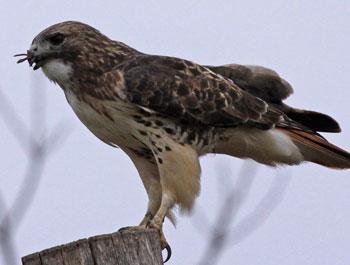Urban Red-tails

Red-tailed Hawk
Photo credit: Laura Erickson
by Clay Christensen
Contributing Writer
As I drive the freeways here in the metro area, I often see a red-tailed hawk sitting atop a light pole, staring intently at the ground. It sometimes seems like a very casual, over-the-shoulder look. This is a classic sit-and-wait predator. From the back it’s usually dark brown with some lighter spots, often forming a V pattern. If it’s facing me, I can usually see a dark band around the belly (which we call a “belly band”).
In flight, you can see the rufous, reddish tail as the hawk turns in the sky. And the underside of the wings often shows dark “comma” or “parenthesis” marks out toward the wingtips.
Red-tailed hawks are the most common and widespread large hawks in North America, but also one of the most variable in coloration and markings. There are very dark varieties, very light varieties, and everything in between. That belly band, for example, isn’t always there, either. In fact, Birds of North America Online notes that there are up to 16 subspecies of red-tailed hawks.
The red-tailed hawk is one of our largest raptors, averaging about 19 inches long with a wingspread of nearly four feet. They weigh only two and a half pounds on average. The female is larger than the male. Red-tails are generally monogamous and have been known to live 21 years, but rarely beyond 17 years.
Red-tailed hawks build a sizable stick nest in the crotch of a large tree. The female begins laying eggs in mid- to late March, generally laying two or three eggs. Incubation lasts for 28 days. After hatching, the nestlings are fed chunks of rodents by both parents. The youngsters are ready to try flight after 42 to 46 days, but they remain with their parents for up to six months longer.
As I’ve noted, red-tails are classic sit-and-wait hunters. They watch for motion in the grasses and then drop and glide to pounce on unsuspecting prey.
Red-tailed hawks also hunt by soaring in circles above fields, using their telescopic vision to focus on a potential meal below. Red-tails eat rodents, rabbits, pheasants, quail, and even snakes.
One of the hazards when catching a rodent is the possibility of being bitten by your prey. Hawks are found with bite marks on their toes and legs from rodents and rabbits. It’s especially a problem with younger hawks that are still learning how to dispatch critters quickly.
The red-tail’s cry is a downward slurring “keer-r-r,” often featured in movies. I love it when the hero steps out onto a dusty cow town street and a red-tail cries somewhere above. Better than a loon, I guess.
Clay Christensen writes The Birdman of Lauderdale column which appears in the St. Anthony Park “Bugle,” where a version of this article first appeared.



